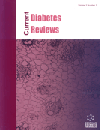- Home
- A-Z Publications
- Current Diabetes Reviews
- Previous Issues
- Volume 10, Issue 2, 2014
Current Diabetes Reviews - Volume 10, Issue 2, 2014
Volume 10, Issue 2, 2014
-
-
Epidemiology of Type 1 Diabetes in Latin America
More LessLatin America is among the regions with the highest diabetes-related burden. Research and treatment programs have increased in number and complexity in recent years, but they are focused in type 2 diabetes, because this condition explains a large proportion of the cases. In contrast, the information regarding the epidemiology of type 1 diabetes is scant in this area. Here, we analyze the available information on this topic Read More
-
-
-
Diabetic Foot and Exercise Therapy: Step by Step The Role of Rigid Posture and Biomechanics Treatment
More LessAuthors: Piergiorgio Francia, Massimo Gulisano, Roberto Anichini and Giuseppe SeghieriLower extremity ulcers represent a serious and costly complication of diabetes mellitus. Many factors contribute to the development of diabetic foot. Peripheral neuropathy and peripheral vascular disease are the main causes of foot ulceration and contribute in turn to the growth of additional risk factors such as limited joint mobility, muscular alterations and foot deformities. Moreover, a deficit of balance, posture an Read More
-
-
-
Laser Treatment for Diabetic Macular Edema in the 21st Century
More LessDiabetic macular edema (DME) is the leading cause of blindness in the diabetic population. The diabetes Control and Complications Trial reported that 27% of patients affected by type 1 diabetes develop DME within 9 years of onset. Other studies have shown that in patients with type 2 diabetes, the prevalence increased from 3% to 28% within 5 years of diagnosis to twenty years after the onset. At the present time, des Read More
-
-
-
Association of Serum Uric Acid and Metabolic Syndrome in Type 2 Diabetes
More LessAuthors: Shokoufeh Bonakdaran and Banafsheh KharaqaniAim: The relationship between elevated serum uric acid level and metabolic syndrome (MS) has been debated. There is no data concerning this relation in Iranian population-based studies. The aim of this study was to determine the prevalence of hyperuricamia and its association with MS in type 2 diabetes mellitus (DM). Patients and Methods: This was a cross- sectional study in 1978 diabetic patients. Hyperuricamia was defi Read More
-
-
-
Type 2 Diabetes and Memory: Using Neuroimaging to Understand the Mechanisms
More LessAuthors: Nicola Jones, Leigh M. Riby, Rachel L.C. Mitchell and Michael A. SmithThe most robust and frequently reported cognitive deficits in type 2 diabetes (DM2) are those that relate to memory. Behavioural research has identified a number of potential contributory physiological factors, including abnormalities in glucose metabolism, such as hyperglycaemia and hypoglycaemia. The impact of these mechanisms on memory has been further investigated through the use of both structural and funct Read More
-
-
-
Glycaemic Control: A Balancing Act or A Different Approach?
More LessBy Stephen FavaThe prevalence of diabetes is increasing world-wide. Tight glycaemic control has been shown to reduce diabetes complications in a number of landmark trials. Apart from increasing the risk of microvascular and macrovascular disease, poor glycaemic control is also associated with cognitive and memory impairment as well as with mood disturbance. However, tighter glycaemic control with conventional anti-hypergl Read More
-
-
-
Leptin- and Leptin Receptor-Deficient Rodent Models: Relevance for Human Type 2 Diabetes
More LessAuthors: Bingxuan Wang, P. Charukeshi Chandrasekera and John J. PippinAmong the most widely used animal models in obesity-induced type 2 diabetes mellitus (T2DM) research are the congenital leptin- and leptin receptor-deficient rodent models. These include the leptin-deficient ob/ob mice and the leptin receptor-deficient db/db mice, Zucker fatty rats, Zucker diabetic fatty rats, SHR/N-cp rats, and JCR:LA-cp rats. After decades of mechanistic and therapeutic research schemes with thes Read More
-
Volumes & issues
-
Volume 21 (2025)
-
Volume 20 (2024)
-
Volume 19 (2023)
-
Volume 18 (2022)
-
Volume 17 (2021)
-
Volume 16 (2020)
-
Volume 15 (2019)
-
Volume 14 (2018)
-
Volume 13 (2017)
-
Volume 12 (2016)
-
Volume 11 (2015)
-
Volume 10 (2014)
-
Volume 9 (2013)
-
Volume 8 (2012)
-
Volume 7 (2011)
-
Volume 6 (2010)
-
Volume 5 (2009)
-
Volume 4 (2008)
-
Volume 3 (2007)
-
Volume 2 (2006)
-
Volume 1 (2005)
Most Read This Month
Article
content/journals/cdr
Journal
10
5
false
en


